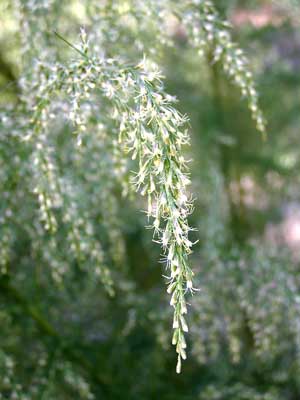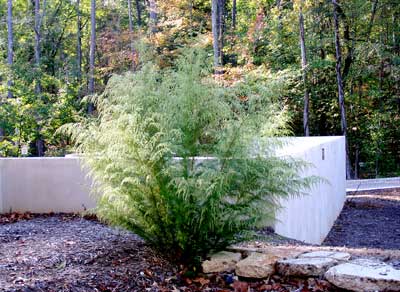Elegant dog fennel

PHOTO BY KEN MOORE. Heads of tiny disc flowers hide in the cascading tops of dog fennel.
By Ken Moore
Flora Columnist
Beautiful, elegant Eupatorium capillifolium. Now that sounds a lot nicer than “beautiful, elegant dog fennel,†doesn’t it? The name dog fennel sounds a bit disreputable, and I suspect the plant was given such an unkind name because it is so very common, and unwanted, in fields and pastures, where it quickly establishes itself, occupying space that could be used by the preferred pasture grasses, feed for cattle and horses.
The leaves of dog fennel are thin and threadlike, closely resembling the lacy foliage of the popular herb fennel. The species epithet, capillifolium, from the Latin, refers to hair-like leaves. As has been described in an earlier Flora story on boneset, the genus name, Eupatorium, is from the Greek, honoring Mithridates Eupator, King of ancient Pontus. This king of long ago is credited with discovering that one of the species of Eupatorium was an antidote against poison, something those ancient politicos apparently needed to have close at hand at mealtimes.
Delving into the meanings of official scientific plant names can lead one off into all sorts of time-consuming and interesting contemplative adventures.
Dog fennel is one of our many native Eupatoriums, that genus in the composite plant family, Asteraceae, characterized by countless heads of tiny disc flowers, arranged in dome-shaped configurations like the easily recognized Joe-pye weed and, more commonly, flat-top configurations like the pretty blue ageratum and the distinctive white-flowered boneset and the several species of thoroughworts that are commonly noticed on roadsides these days.
In contrast, dog fennel grows taller and taller along roadsides and in fields throughout the growing season, looking like wavy-haired green weeds and carefully avoided by any and all grazing animals, wild or domesticated.
Spread across the larger landscape, dog fennel is not appreciated for the elegantly beautiful plant it is. When seen out of its normal context as a single specimen or as a few scattered here and there, one is more inclined to pause and take a closer look. Such an experience is easy and enjoyable these days around the emerging landscape of the N.C. Botanical Garden’s new Visitor Education Center.
The beauty of the tall stems, standing still or swaying in the breeze, changes as sunlight streams through the hair-like foliage, changing colors with each hour. Taking time to study individual plants, you will discover that some of the plants bear stems of burgundy red, nicely contrasting with the green-stemmed specimens nearby.
For flower arrangers, stems of the lacey foliage provide a lovely foil for any selection of flowers and grasses, and the resulting arrangements are not available from florists.
This plant has a wonderfully described herbal heritage. A tea of the roots was a common treatment for fevers. More interesting is the practice by some herbal “conjurers†or “rootworkers†of using drops of a concoction of boiled stems and leaves to make an unsuspecting person obey their every command. There are other unbelievable herbal attributes, which I’ll leave you to discover in a local library.
Email Ken Moore at flora@carrborocitizen.com.

PHOTO BY KEN MOORE. A graceful specimen, dog fennel stands out at the N.C. Botanical Garden.
Comments are closed.